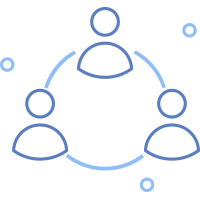Unlock continuous skill development by helping each person both learn and teach
We wanted to share this article from McKinsey titled “Reviving the art of apprenticeship to unlock continuous skill development” and wanted to call out some key passages that are highly relevant in what most organizations are trying to accomplish. Taking advantage of task-based mentors/peer mentors (what McKinsey calls distributed apprenticeship) is key to upskilling and reskilling at scale in the flow of work.
A distributed apprenticeship model begins with the belief that everyone shares two obligations: the responsibility to learn and the responsibility to teach. Apprenticeship is neither general coaching nor feedback. Instead, it is a focused effort aimed at intentionally building specific skills. Because apprenticeship is bidirectional, everyone must have the skills to both apprentice someone and be apprenticed.
Building a culture of teachers starts with letting go of the antiquated notion that domain skills are tied to tenure or seniority. Teachers can be anyone in an organization, even peers or junior colleagues who possess a skill that others need to build.
Apprenticeship environments flourish in organizations with strong learning cultures because those cultures emphasize the importance of every person taking ownership for their development and growing their skills. By fostering a culture of intentional learners, organizations build in their employees a readiness to act as apprentices. Intentional learners embrace both the mindsets and skills that allow them to learn in every context, effectively seek and act on feedback, reflect on their progress, and practice. These same principles are the building blocks for apprenticeship relationships.
Learning and teaching take real time and cannot thrive in a culture where leaders are not reinforcing their importance. Leaders who tangibly and visibly invest in their own learning and are transparent about their vulnerabilities create a psychologically safe environment that values progress over perfection.
Create incentives to encourage individuals to both teach and learn. Individuals should find it easy to identify skills that are important to the organization [your competency model], assess themselves against those skills, express their intent to learn, formulate a plan, receive support, and be held accountable. [If you’ve been reading our blogs, does this sound familiar?]
Then set expectations [for example, completing 1 activity/month] and give learners choices in how to meet those expectations [learning options]. Encourage them to pursue skill-building opportunities that interest them and begin to shift success metrics away from completion and toward consumption. The goal: providing rich learning experiences and inviting everyone in an organization to learn all the time without mandating specific actions.
We believe that the best apprenticeship relationships are built on domain expertise. [So do we! That’s the purpose of the SDLE Mentorship function.]
This means there are significantly more apprenticeship opportunities in a modern organization than might meet the eye. Given the right circumstances, anyone can learn from anyone else. For leaders charged with overseeing learning, the impermanence of modern apprenticeship puts a premium on knowing the specific skills employees need to build and giving them access to a multiplicity of experts from whom they can learn.
Today’s upskilling and reskilling needs require organizations to respond with both speed and scale. While formal learning will always play a critical role in shaping workforce skills, creating an apprenticeship culture unlocks learning at the point where the work is done. It democratizes skill building and empowers both those with expertise and those who need guidance to direct how best to overcome skill gaps. But more than this, apprenticeship can serve as the networked fabric that knits an organization together. At its core, it’s a deep relationship between people and gives organizations yet another tool through which they can foster cohesion, meaning, purpose, and connection.
If you’re looking to capitalize on this trend, contact us so you can learn how the SDLE’s Mentorship function can help you intentionally building specific skills. Modern apprenticeship is just a click away!


